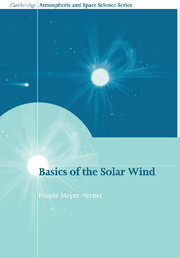Book contents
- Frontmatter
- Contents
- Preface
- 1 The wind from the Sun: an introduction
- 2 Tool kit for space plasma physics
- 3 Anatomy of the Sun
- 4 The outer solar atmosphere
- 5 How does the solar wind blow?
- 6 Structure and perturbations
- 7 Bodies in the wind: dust, asteroids, planets and comets
- 8 The solar wind in the Universe
- Appendix
- Index
1 - The wind from the Sun: an introduction
Published online by Cambridge University Press: 22 October 2009
- Frontmatter
- Contents
- Preface
- 1 The wind from the Sun: an introduction
- 2 Tool kit for space plasma physics
- 3 Anatomy of the Sun
- 4 The outer solar atmosphere
- 5 How does the solar wind blow?
- 6 Structure and perturbations
- 7 Bodies in the wind: dust, asteroids, planets and comets
- 8 The solar wind in the Universe
- Appendix
- Index
Summary
‘First accumulate a mass of Facts: and then construct a Theory.’ That, I believe, is the true Scientific Method. I sat up, rubbed my eyes, and began to accumulate Facts.
Lewis Carroll, Sylvie and BrunoNot only does the Sun radiate the light we see – and that we do not see – but it also continually ejects into space 1 million tonnes of hydrogen per second. This wind is minute by astronomical standards; it carries a very small fraction of the solar energy output, and compared to the violent explosions pervading the universe it blows rather gently. Yet it has amazing effects on the solar surroundings. It blows a huge bubble of supersonic plasma – the heliosphere – which engulfs the planets and a host of smaller bodies, shaping their environments. It also conveys perturbations that can be seen in our daily life.
The object of this chapter is twofold. To give a concise historical account of the key ideas and observations that made our modern view of the solar wind emerge; and introduce the main properties of the Sun and of its wind, and their interpretation in terms of basic physics. The latter goal requires some tools of plasma physics, and will be developed in the rest of the book.
A brief history of ideas
The idea that planets are not moving in a vacuum is very old.
- Type
- Chapter
- Information
- Basics of the Solar Wind , pp. 1 - 40Publisher: Cambridge University PressPrint publication year: 2007

